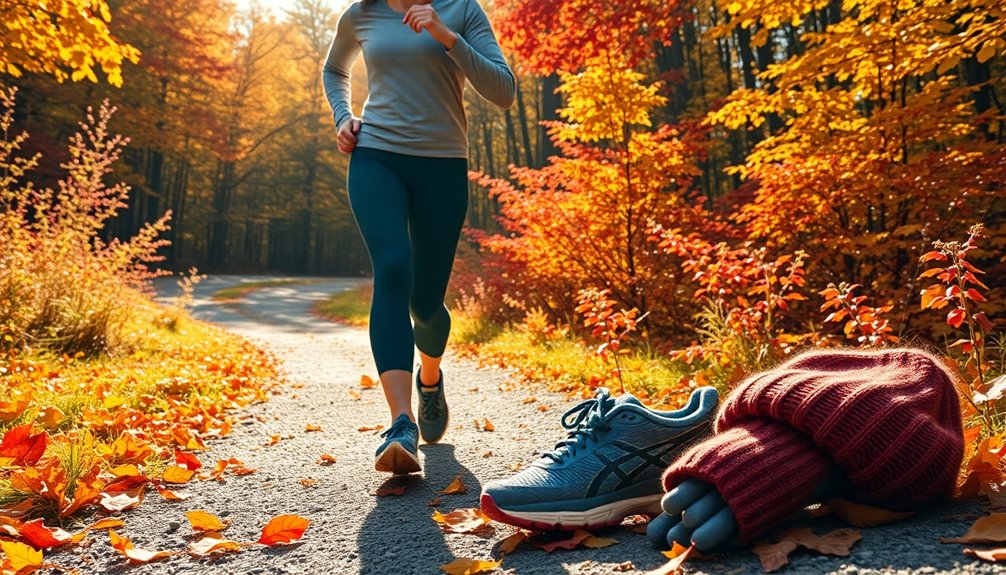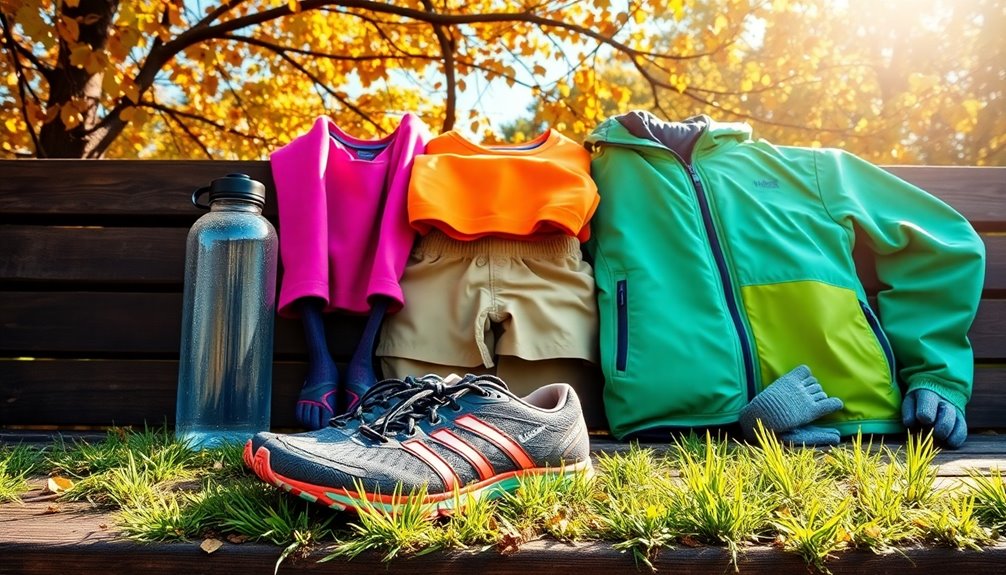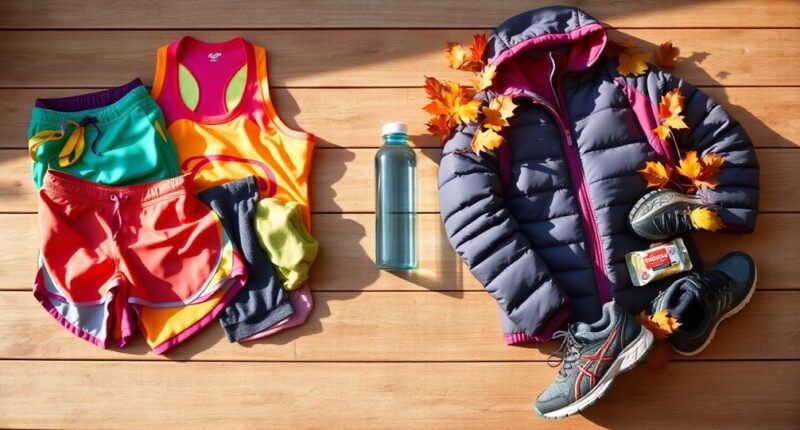To adapt your running setup for each season, start by evaluating your current gear for fit and repair needs. Layer wisely in autumn with moisture-wicking base layers, thin middle layers, and water-repellent outer layers. Adjust your footwear for better grip in wet and icy conditions, and stay hydrated with nutritious foods like apples and soups. Don’t forget to invest in safety gear for low-light runs. With these tips, you’ll be ready for seasonal changes ahead. In winter, consider adding thermal accessories such as gloves, hats, and neck gaiters to keep warm during chilly runs. As the weather transitions to spring, it’s a great time to refresh your collection of ultimate running gear essentials, making sure your shoes provide adequate support for the longer distances ahead. Always listen to your body, and don’t hesitate to make adjustments to your routine or gear as needed to ensure a safe and enjoyable running experience year-round.
Key Takeaways
- Assess and organize your running gear by season, discarding worn-out items and identifying essentials for adaptability.
- Implement layering strategies, starting with moisture-wicking base layers and adding insulation for varying temperatures.
- Choose appropriate footwear for different weather conditions, ensuring grip and comfort on wet or icy surfaces.
- Maintain hydration and nutrition tailored to seasonal demands, focusing on complex carbohydrates and warming meals for energy.
- Prioritize safety with reflective gear and headlamps during low-light conditions, ensuring visibility on your runs.
Assessing Your Current Running Gear

How well do you know your current running gear? It's time to assess what you've got. Start by checking if your items fit properly or need repair. Discard any worn-out pieces that don't serve you anymore.
Organize your gear by season, separating summer from fall, and identify crossover items. Focus on essentials like moisture-wicking fabrics and suitable footwear that adapt to changing weather conditions.
Don't overlook the importance of comfort and safety; make certain you have reflective gear for those shorter daylight hours in fall and winter. Regularly updating your collection will keep you prepared for seasonal changes, enhancing your overall performance.
Embrace this opportunity to refine your running setup and enjoy your runs more than ever!
Layering Strategies for Fall Runs

As the temperatures drop and leaves change color, mastering layering strategies is essential for enjoyable fall runs. Start with a fitted moisture-wicking base layer to keep sweat away and reduce hypothermia risk. Next, add a thin long-sleeved middle layer, like a half-zip, for warmth and ventilation. Top it off with a flexible outer layer, such as a water-repellent jacket, to guard against wind and light rain. Shift to running tights to maintain body heat while benefiting from moisture-wicking properties. Don't forget accessories like hats, gloves, and headbands for added insulation. Additionally, it's crucial to stay hydrated during your runs, as hydration plays a key role in maintaining your performance and overall health.
| Layer Type | Purpose | Example |
|---|---|---|
| Base Layer | Moisture-wicking | Fitted long-sleeve shirt |
| Middle Layer | Extra warmth and ventilation | Thin half-zip top |
| Outer Layer | Protection from elements | Water-repellent jacket |
Essential Gear for Autumn Running

As autumn sets in, you need to adjust your gear to handle cooler temperatures and unpredictable weather.
Layering for temperature control is vital, along with selecting the right footwear for wet conditions.
Don't forget essential accessories for safety, especially as daylight fades earlier in the season.
Layering for Temperature Control
When the crisp autumn air sets in, layering becomes essential for maintaining comfort during your runs. Start with a fitted base layer made from moisture-wicking fabric to keep sweat away from your skin and reduce the risk of hypothermia.
Next, add a thin long-sleeved middle layer, like a half-zip running top, which provides insulation while allowing for ventilation. For your outer layer, choose a flexible, water-repellent jacket to shield against wind and light rain.
Shift from lighter summer shorts to running tights, which help retain body heat during cooler runs.
Don't forget to accessorize with hats, gloves, and headbands; these items are vital for keeping your extremities warm and adapting to fluctuating fall temperatures. Additionally, remember to apply sunscreen application on exposed skin to protect against UV damage, even in cooler weather.
Footwear for Wet Conditions
While you gear up for those rainy autumn runs, choosing the right footwear is essential for both safety and comfort. Look for waterproof running shoes that keep your feet dry and help reduce the risk of blisters. Shoes with deeper treads provide better grip on wet surfaces, ensuring you maintain traction on slippery paths. Additionally, opt for moisture-wicking materials to manage sweat and keep your feet comfortable. Don't forget to switch to longer moisture-wicking socks to protect against chilly conditions. Investing in quality footwear can also help you save on home security system costs, as a good running setup minimizes the risk of injuries and safety concerns while out on the trails.
| Feature | Benefits | Recommendations |
|---|---|---|
| Deeper Treads | Better grip on wet surfaces | Trail running shoes |
| Waterproof Materials | Keeps feet dry | Gore-Tex or similar |
| Longer Moisture-Wicking Socks | Protects against blisters | Thicker, cushioned designs |
Essential Accessories for Safety
Autumn running demands a focus on safety, especially with shorter daylight hours. Wearing bright or reflective clothing is essential to enhance visibility during those low-light runs.
Don't forget important accessories like strobing clip-on lights or reflective vests to further boost your presence on the road. As temperatures drop, an insulating layer along with waterproof accessories keeps you comfortable and protected from the elements.
Hats and gloves not only retain body heat but also add to your safety. Moisture-wicking socks are critical for keeping your feet dry and warm, preventing blisters in cooler, wetter conditions. Additionally, using broad-spectrum sunscreen is vital even in cooler months to protect your skin from harmful UV rays.
Prioritizing these accessories guarantees you stay safe and comfortable while enjoying your autumn runs.
Seasonal Footwear Adjustments

As the seasons change, it's essential to adjust your footwear to match the conditions.
You'll want to choose running shoes with the right grip for wet surfaces and opt for longer moisture-wicking socks to keep your feet dry and blister-free.
Staying aware of weather-responsive shoe types can make all the difference in your comfort and performance.
Appropriate Grip Selection
Choosing the right grip for your running shoes is essential, especially as the seasons change.
In winter, opt for shoes with good traction featuring aggressive lugs and rubber outsoles to tackle icy conditions. Consider adding microspikes for extreme traction.
Spring brings seasonal challenges, so select shoes with versatile grip patterns to manage both wet and dry surfaces.
For summer, lightweight shoes with breathable mesh uppers and minimal tread will keep you comfortable on dry terrain.
As autumn arrives, shift to shoes with deep treads for stability on fallen leaves and wet paths.
Don't forget to regularly assess your footwear; replace worn-out shoes when the outsole shows significant wear to maintain appropriate grip selection and guarantee a safe running experience. Additionally, HEPA filtration can enhance air quality indoors, which is beneficial for runners focusing on respiratory health.
Moisture-Wicking Sock Choices
While you might reach for lighter socks during the blazing summer months, shifting to moisture-wicking options in cooler weather is essential for maintaining comfort on your runs.
Look for socks made from synthetic materials like polyester or nylon, as these moisture-wicking fabrics keep your feet dry and reduce the risk of fungal infections.
In fall and winter, opt for longer socks that provide added cushioning and insulation to enhance comfort while ensuring breathability. Choose designs that feature arch support and seamless construction to minimize friction during longer runs.
Always prioritize foot health by selecting socks that fit well without constricting, ensuring ideal circulation and preventing discomfort or numbness.
Adapting your sock choices makes all the difference in your seasonal running experience.
Weather-Responsive Shoe Types
Adapting your running gear doesn't stop at socks; your shoe selection should also respond to seasonal changes. Each season brings different weather conditions that require thoughtful footwear choices.
| Season | Recommended Shoe Features |
|---|---|
| Winter | Enhanced traction, rubber outsoles |
| Spring | Breathable mesh uppers, good drainage |
| Summer | Lightweight, moisture-wicking properties |
| Fall | Aggressive tread pattern, support |
In winter, opt for shoes with added traction devices for icy surfaces. Spring needs breathable mesh uppers to handle moisture, while summer calls for lightweight shoes to keep your feet cool. For fall, shoes with an aggressive tread pattern help you navigate slippery leaves. Don't forget to adjust your socks accordingly!
Nutrition and Hydration Changes for Fall

As the temperatures drop in fall, it's crucial to adjust your nutrition and hydration strategies to maintain your energy levels and overall health.
Focus on incorporating more complex carbohydrates, like whole grains and root vegetables, to fuel your runs. Seasonal superfoods such as apples and pumpkins are great for providing important vitamins and minerals that support your immune system during cooler temperatures.
Don't forget to stay hydrated; aim for at least 64 ounces of water daily while monitoring your hydration levels, as the chill can mask signs of dehydration.
Warming meals like soups and stews can aid in recovery and energy replenishment, offering both hydration and sustenance pre- and post-run. Including high-calorie breakfasts can also help provide the energy needed for longer runs during the fall months.
Staying proactive with your nutrition and hydration will keep you energized all season long.
Mental Preparedness for Seasonal Transitions

With the change in seasons, it's important to focus not just on your physical preparation but also on your mental readiness. Seasonal shifts can challenge your motivation, so set small, achievable goals to keep your focus sharp.
Embrace each season's unique challenges to build resilience and adapt your training strategies. Reflect on your past achievements and set new goals to enhance your commitment to your running routine.
Practicing mindfulness during runs, especially in bleak winter conditions, can help maintain a positive outlook. Additionally, consider joining running groups or communities; the social support they offer can boost your motivation and keep you engaged. Moreover, be aware that your astrological compatibility can influence your social interactions and motivation levels during different seasons.
Safety Tips for Running in Changing Weather

When you're running in changing weather, choosing the right gear is essential for your safety.
You'll want to focus on visibility, hydration, and nutrition adjustments to keep yourself both seen and fueled.
Let's explore how to stay safe and comfortable no matter the conditions you face. Incorporating effective relaxation techniques can also help manage stress during challenging weather conditions.
Weather-Appropriate Clothing Choices
Running in changing weather can be challenging, but choosing the right clothing keeps you comfortable and safe.
Start with a moisture-wicking base layer to draw sweat away, then add an insulating mid-layer for warmth, topped with a weather-resistant outer layer to shield against wind and rain.
For your shoes, pick options that offer good traction and support; waterproof shoes work well in wet conditions, while breathable ones are perfect for hot days.
Don't forget reflective clothing and accessories to enhance your visibility during those darker hours in fall and winter.
In spring, opt for lightweight, quick-drying fabrics, and always stay hydrated.
Visibility and Light Gear
As daylight fades during the fall and winter months, guaranteeing your visibility on the road becomes essential for your safety.
Invest in reflective gear and wear bright colors to enhance your visibility in low-light conditions, especially if you're running outside early in the morning or late in the evening.
A headlamp can illuminate dark trails, helping you spot potential hazards while enhancing your visibility.
Opt for moisture-wicking, lightweight clothing with reflective elements to maintain comfort during unpredictable weather changes.
Don't forget to regularly check and replace batteries in your safety lights and reflective gear to guarantee they work effectively.
Hydration and Nutrition Adjustments
Staying hydrated and properly fueled is essential for your performance, especially as the seasons change.
In winter, drink water regularly, even if you don't feel thirsty, since cold air can lead to dehydration.
During summer, prioritize hydration with about 17-20 ounces of fluid two hours before a run and 7-10 ounces every 10-20 minutes while running.
In spring, monitor pollen counts and time your runs for early mornings or late evenings to reduce allergy exposure while maintaining hydration to combat reactions.
Adjust your nutrition in winter by focusing on complex carbohydrates and healthy fats, and enjoy warming foods like soups.
For summer, include hydrating foods like watermelon and cucumber to support your fluid intake and overall hydration. Additionally, understanding safe internet practices can help you navigate online resources for nutrition advice as well.
Cross-Training Opportunities During Fall

While the leaves change and temperatures drop, fall presents an ideal opportunity to diversify your fitness routine through cross-training. Embrace the cooler weather and consider these options to enhance your running performance:
- Cycling: This low-impact activity boosts cardiovascular fitness while being gentle on your joints.
- Strength Training: Focus on exercises like squats and lunges to build muscle endurance, targeting key running muscles.
- Hiking: Enjoy the beautiful foliage while improving strength and endurance on varied terrain.
Additionally, don't overlook swimming for a full-body workout or yoga for improved flexibility and core strength. Engaging in these activities not only improves your fitness but also encourages a sustainable approach to maintaining overall health and performance.
Incorporating these activities into your routine can help reduce injury risk and keep you motivated as you shift to higher mileage this season.
Embracing the Scenic Routes of Autumn

Autumn transforms the landscape into a vibrant tapestry of colors, inviting you to explore scenic routes that enhance your running experience.
The cooler temperatures and lower humidity make it perfect for longer distances and speed work, while the stunning fall foliage boosts your motivation to discover new paths.
As daylight fades, wearing bright or reflective clothing guarantees your visibility on these scenic routes, keeping you safe during evening runs.
Be mindful of fallen leaves; they can be slippery and may hide uneven terrain, so adjust your stride and stay focused.
This season is also a great time to set personal running goals, as the combination of comfortable weather and beautiful scenery inspires performance improvements.
Staying Motivated Through Seasonal Changes

As the seasons shift, it's essential to find ways to keep your motivation high and your running routine fresh. Here are three strategies to help you stay motivated through seasonal changes:
- Set Achievable Seasonal Goals: Define clear, attainable goals to focus your efforts and track your progress.
- Join a Running Group: Embrace the elements with a supportive community. A running group can enhance accountability and keep you engaged during tougher seasons.
- Add Variety to Your Routine: Explore new routes or incorporate cross-training activities. This variety not only prevents burnout but also enhances your running experience.
Frequently Asked Questions
What Is the 80% Rule in Running?
The 80% Rule in running suggests you should do 80% of your training at an easy, conversational pace. This helps build endurance and reduces injury risk.
The remaining 20% of your workouts can focus on higher intensity efforts like speed work.
By following this approach, you allow your body to recover and adapt, enhancing your overall performance while maintaining a sustainable training schedule.
It's a great strategy for runners at any level.
How Do You Structure a Running Season?
To structure your running season, break it into four phases: winter, spring, summer, and fall.
In winter, focus on maintaining fitness with shorter, slower runs.
Spring's your time to gradually increase mileage and add strength training.
During summer, prioritize hydration and run in cooler parts of the day.
Finally, fall's perfect for speed and endurance workouts, as you set personal goals while adapting to cooler temperatures and wetter conditions.
What Is the 80/20 Rule for Trail Running?
The 80/20 Rule for trail running means you should spend 80% of your training at a low intensity and only 20% at high intensity.
This approach helps you build endurance while minimizing injury risk. By focusing on low-intensity runs, you enhance your aerobic capacity and overall performance.
Incorporating high-intensity efforts sparingly allows you to improve speed without burning out.
Following this rule can lead to better results in your trail running journey.
How Long Does It Take the Body to Adapt to Running?
Imagine your body as a garden. When you first plant seeds, it takes time for them to sprout.
Similarly, when you start running, your body needs about 2 to 4 weeks to adapt. You'll notice early changes in coordination and strength, but after 4 to 6 weeks, your endurance will bloom as your aerobic capacity improves.
With consistent training, you'll cultivate long-term gains in muscle mass and bone density over several months.
Conclusion
As the leaves turn and the air crispens, it's the perfect time to cozy up your running routine. Embracing the seasonal shift means adjusting your gear, savoring those vibrant trails, and fueling your body right. Don't forget to stay safe as the weather plays its little games. With a sprinkle of motivation and a dash of adventure, you'll find joy in every step this autumn. So lace up, and let the beauty of the season inspire your runs!









